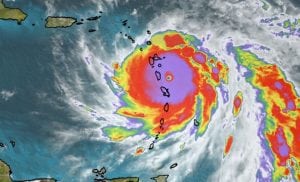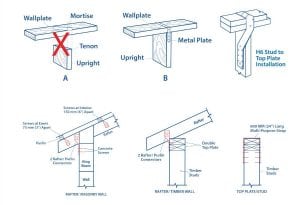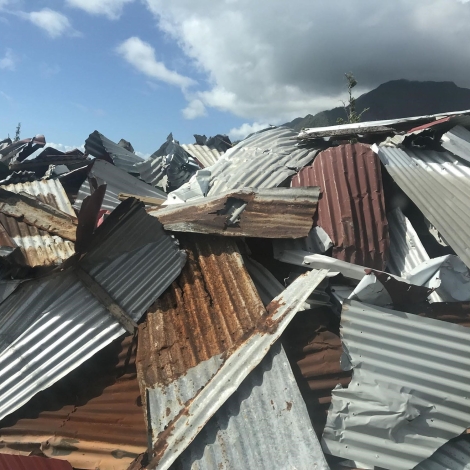 The first Category 5 Hurricane ever recorded to make landfall in the Lesser Antilles arc of Caribbean islands decimated Dominica on September 18, 2017. Hurricane Maria devastated communities and the landscape, destroying homes, disrupting public services and necessitating a widespread debris cleanup. Ninety percent of housing stock was damaged, according to the Post Disaster Needs Assessment. Roughly 23,500 homes (75 percent of the total) had suffered partial damage—primarily roof loss or damage. About 4700 houses (15 percent) were considered razed. The remaining 3135 (10 percent) were unaffected. Aid workers estimated an excess of (USD) $354 million in damage to the housing sector. This estimate includes the replacement cost of destroyed houses and household goods as well as the repair of partially damaged houses.
The first Category 5 Hurricane ever recorded to make landfall in the Lesser Antilles arc of Caribbean islands decimated Dominica on September 18, 2017. Hurricane Maria devastated communities and the landscape, destroying homes, disrupting public services and necessitating a widespread debris cleanup. Ninety percent of housing stock was damaged, according to the Post Disaster Needs Assessment. Roughly 23,500 homes (75 percent of the total) had suffered partial damage—primarily roof loss or damage. About 4700 houses (15 percent) were considered razed. The remaining 3135 (10 percent) were unaffected. Aid workers estimated an excess of (USD) $354 million in damage to the housing sector. This estimate includes the replacement cost of destroyed houses and household goods as well as the repair of partially damaged houses.
The damage did not end there. The overflow of waste and debris created environmental and public health issues. Construction rubble, home appliances, and corrugated metal roofing materials continue to accumulate in empty lots and along roadsides across the island. Dominica Solid Waste Management does not have the capacity to remedy this situation, which worsens with each repaired home.
While excess waste is generally problematic, in this context it can be an opportunity. Brick-by-Brick, a US-based non-profit working with local Dominica partners to build more resilient communities, plans to transform waste metal into low-cost hurricane straps. The project has the potential to amend two problems, it reduces construction waste and it may lower the cost of building hurricane-resistant housing.
Hurricane straps are a recommendation in the new Guide to Dominica’s Housing Standards. In the wake of the hurricane, Engineers Without Borders – USA and other international non-governmental organizations worked with Dominica’s government to develop the guide. The guide provides new codes and specifications to address the need for climate-resilient and seismic-resistant residential housing construction. It is an easy reference for stakeholders involved in partial or complete reconstruction of residential buildings and roofs.
 Hurricane straps are one method the guide prescribes to improve the strength of critical connection points in timber-framed construction. Simpson Strong-Tie is an example. They are, however, expensive. EWB estimates that the use of hurricane straps increased the cost of roof reconstruction by roughly 30 percent. Many of the 4700 houses designated as completely destroyed were small timber-framed homes in rural communities. The estimated cost to rebuild such structures with hurricane-resistant materials increases by 50-60 percent. The additional cost threatens to leave many of the poorest, most vulnerable communities that suffered the heaviest damage unable to rebuild in compliance with the new housing standards.
Hurricane straps are one method the guide prescribes to improve the strength of critical connection points in timber-framed construction. Simpson Strong-Tie is an example. They are, however, expensive. EWB estimates that the use of hurricane straps increased the cost of roof reconstruction by roughly 30 percent. Many of the 4700 houses designated as completely destroyed were small timber-framed homes in rural communities. The estimated cost to rebuild such structures with hurricane-resistant materials increases by 50-60 percent. The additional cost threatens to leave many of the poorest, most vulnerable communities that suffered the heaviest damage unable to rebuild in compliance with the new housing standards.
Brick-by-Brick proposes to recycle waste metal and locally produce hurricane straps that it will brand as “Restor-Ties” (Recycled Steel Origami Ties). The organization is in the process of identifying and coordinating partners in the US and Dominica to ensure that the designs meet or exceed ‘Simpson Strong-Tie’ engineering specifications while offering a lower cost option to the market.
In-country fabrication and real-world application will provide empirical information. Feedback will be collected in cooperation with the Science and Technology Office at the Ministry of Education, Recycle Rebuild, EWB and the UN Development Programme. Potential pilot projects include small demonstration homes on the property of a UNDP employee from Dominica, and homes in Dominica’s indigenous community, the Kalinago Territory.
Presently, with help from Engineering for Change, we are seeking academic and professional partners in the United States to test our designs according to ASTM’s international standards. Although this material will have varying tolerances, quality control will be a major hurdle. Over-engineering the Restor-Ties may initially mitigate these problems. The long-term goal will be the creation of a small-scale production facility on the island of Dominica to manufacture a product vital to resilient construction throughout the Caribbean, while creating much needed local employment opportunities. We anticipate transitioning from waste metal to manufactured cold formed steel roll stock due to the limited stock of readily available waste metal.
About the Authors
R. David Gibbs specializes in design, engineering, installation, and project management of renewable energy systems. After assisting with post-Hurricane Maria relief, he co-founded the non-profit Brick-by-Brick, and continues to be involved with skill development and cultivating local entrepreneurship via sustainable technologies.
Matt Sisul is a structural/civil engineer, international development practitioner and educator. He teaches Engineering for Developing Communities at Columbia University.

